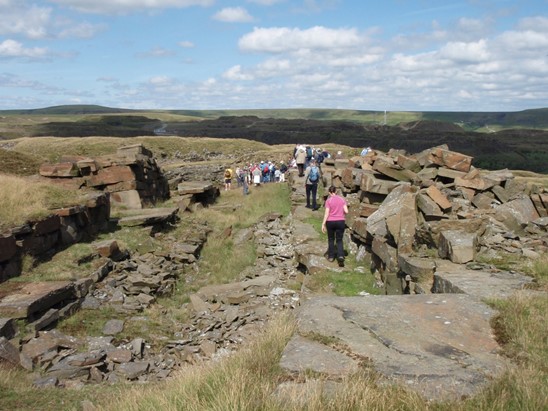Ab Top quarry extends from NGR: SD 871 196 to SD 874 196 and lies at c. 350 m O.D (Ordenance Datum, Above Sea level). The quarry can be accessed by following the line of the mineral tramway which connects Ab Top with Ragstone Brow and Thurns Head quarry.
Historical Summary
Working life: Operating by 1844 (OS 1st edn). Possibly disused by 1930.
Quarry firms: Abraham Sanderson? Maxwells (Collins 1960).
Geology: Haslingden Flags.
Methods: Hillside outcropping and open pits. Techniques included blasting to clear turf, shale and hand digging with picks (Collins 1960, 29-33).
Transport: Loading area served by horse and lorry. Four line tramway later served the quarry using a steam locomotive at first, but then reverting to horse power as the gradient was too steep. Gravity tramway near Hallfold for taking away the coal mined from a seam near Ab Top Quarry (Collins 1960, 29-33).
Products: Engine beds, kerbs, flags and setts (Collins 1960, 32).
Events:
1844 OS 6” 1st edn shows ‘Ab Top Quarry (Sandstone)’.
c. 1910 35 men employed at Ab Top quarry (Collins 1960, 32).
Field Components Summary: This moderately sized quarry has evidence for open pit working in the form of a large arcing working face situated on the summit of Ab Top and hillside outcrop working, which is confined to the slopes of Walstead Clough. The spoil mounds associated with these workings are visible and consist predominantly of spoil fingers, particularly within a large infilled extraction pit, which appears to have been filled with quarry spoil between 1893 and 1910. Throughout the majority of the quarry many of these spoil fingers are, however, obscured through recent episodes of spoil tipping associated with the workings at Britannia quarry. Other features related with the early workings at Ab Top include a sections of partially spoiled over tramway , with visible sections of kerbing, which terminate within a well defined processing area. Two substantial ruinous quarry buildings, which might have functioned as quarry manager’s offices, and the possible settings for a crane and travelling crane are also associated with this processing area. At the eastern end of the quarry are also other smaller processing areas and two quarrymen’s shelters.

